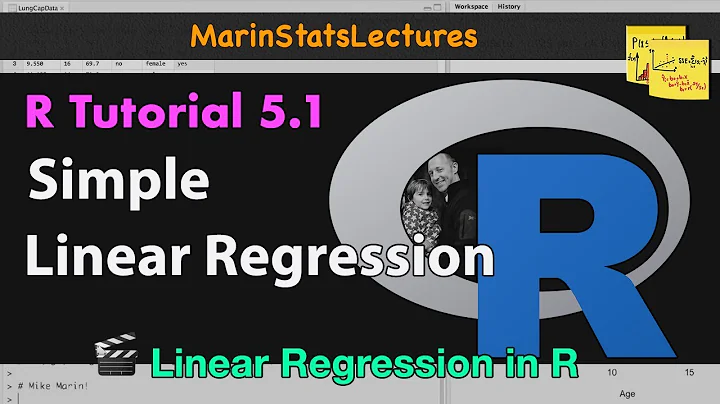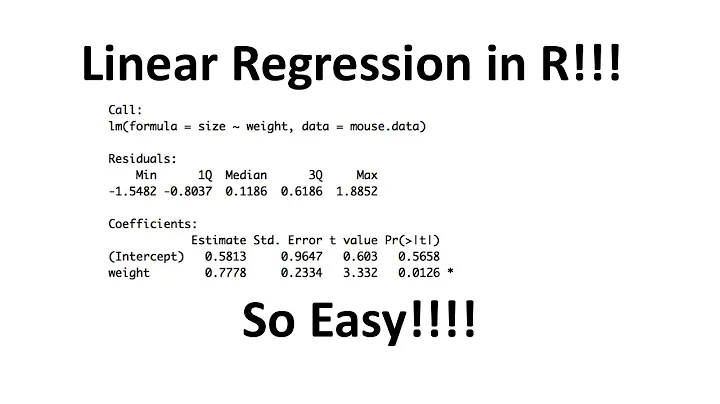Force certain parameters to have positive coefficients in lm()
Solution 1
You could use the package colf for this. It currently offers two least squares non linear optimizers, namely nls or nlxb:
library(colf)
colf_nlxb(y ~ x1 + x2 + x3, data = DF, lower = c(-Inf, 0, 0, -Inf))
#nlmrt class object: x
#residual sumsquares = 169.53 on 98 observations
# after 3 Jacobian and 3 function evaluations
# name coeff SEs tstat pval gradient JSingval
#1 param_X.Intercept. -0.0066952 NA NA NA 3.8118 103.3941
#2 param_x1 0.0000000 NA NA NA 103.7644 88.7017
#3 param_x2 0.0000000 NA NA NA 0.0000 9.8032
#4 param_x3 -0.9487088 NA NA NA 330.7776 0.0000
colf_nls(y ~ x1 + x2 + x3, data = DF, lower = c(-Inf, 0, 0, -Inf))
#Nonlinear regression model
# model: y ~ param_X.Intercept. * X.Intercept. + param_x1 * x1 + param_x2 *
# x2 + param_x3 * x3
# data: model_ingredients$model_data
#param_X.Intercept. param_x1 param_x2 param_x3
# -0.0392 0.0000 0.0000 -0.9801
# residual sum-of-squares: 159
#
#Algorithm "port", convergence message: both X-convergence and relative convergence (5)
You can set the lower and/or upper bounds to specify the limits as you like for each one of the coefficients.
Solution 2
You can use package penalized:
set.seed(1)
x1=c(NA,rnorm(99)*10)
x2=c(NA,NA,rnorm(98)*10)
x3=rnorm(100)*10
y=sin(x1)+cos(x2)-x3+rnorm(100)
DF <- data.frame(x1,x2,x3,y)
lm(y~x1+x2+x3, data=DF)
#Call:
#lm(formula = y ~ x1 + x2 + x3, data = DF)
#
#Coefficients:
#(Intercept) x1 x2 x3
# -0.02438 -0.01735 -0.02030 -0.98203
This gives the same:
library(penalized)
mod1 <- penalized(y, ~ x1 + x2 + x3, ~1,
lambda1=0, lambda2=0, positive = FALSE, data=na.omit(DF))
coef(mod1)
#(Intercept) x1 x2 x3
#-0.02438357 -0.01734856 -0.02030120 -0.98202831
If you constraint the coefficients of x1 and x2 to be positive, they become zero (as expected):
mod2 <- penalized(y, ~ x1 + x2 + x3, ~1,
lambda1=0, lambda2=0, positive = c(T, T, F), data=na.omit(DF))
coef(mod2)
#(Intercept) x3
#-0.03922266 -0.98011223
Related videos on Youtube
Yu Deng
Updated on June 04, 2022Comments
-
Yu Deng almost 2 years
I would like to know how to constrain certain parameters in
lm()to have positive coefficients. There are a few packages or functions (e.g.display) that can make all coefficients, and the intercept, positive.For instance, in this example, I would like to force only
x1andx2to have positive coefficients.x1=c(NA,rnorm(99)*10) x2=c(NA,NA,rnorm(98)*10) x3=rnorm(100)*10 y=sin(x1)+cos(x2)-x3+rnorm(100) lm(y~x1+x2+x3) Call: lm(formula = y ~ x1 + x2 + x3) Coefficients: (Intercept) x1 x2 x3 -0.06278 0.02261 -0.02233 -0.99626I have tried function
nnnpls()in packagennls, it can control the coefficient sign easily. Unfortunately I can't use it due to issues withNAs in the data as this function doesn't allowNA.I saw function
glmc()can be used to apply constraints but I couldn't get it working.Could someone let me know what should I do?
-
Hercules Apergis over 6 yearsThis would be more interesting if no package was to be involved; say that one would want to apply it in a non OLS setting.
-
Martijn Pieters about 4 yearsPlease include disclosure in your post when posting about your own projects.















